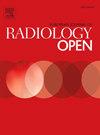Peroneus brevis split tear – A challenging diagnosis: A pictorial review of magnetic resonance and ultrasound imaging. Part 1. Anatomical basis and clinical insights
IF 1.8
Q3 RADIOLOGY, NUCLEAR MEDICINE & MEDICAL IMAGING
引用次数: 0
Abstract
Diagnosing peroneus brevis split tears is a significant challenge, as many cases are missed both clinically and on imaging. Anatomical variations within the superior peroneal tunnel can contribute to peroneus brevis split tears or instability of the peroneal tendons. However, determining which anatomical variations predispose patients to these injuries remains challenging due to conflicting data in the literature. In this review, we present the current understanding of the role of anatomical variants in the development of peroneus brevis split tears. Many studies emphasize the significance of the retromalleolar groove and retromalleolar tubercle, the impact of a low-lying muscle belly, and the presence of accessory muscles within the superior peroneal tunnel as contributors to peroneal pathology. Hypertrophy of the peroneal tubercle or post-traumatic irregularities in the surface of the retromalleolar groove can accelerate degenerative changes in the peroneal tendons, potentially leading to peroneus brevis split tears. The topographic anatomy of the superior peroneal tunnel is essential for systematically performing ultrasound and interpreting magnetic resonance imaging of the ankle. The first part of this review focuses on the anatomical foundations of imaging diagnostics for peroneus brevis pathology. In the second part, we will examine the radiological spectrum of peroneal tendon injuries, offering a framework to enhance diagnostic confidence in this frequently underdiagnosed pathology.
腓骨短肌撕裂-一个具有挑战性的诊断:磁共振和超声成像的图像回顾。第1部分。解剖学基础和临床见解。
诊断腓骨短肌撕裂是一个重大的挑战,因为许多病例在临床和影像学上都被遗漏了。腓骨上隧道内的解剖变异可导致腓骨短肌撕裂或腓骨肌腱不稳定。然而,由于文献中相互矛盾的数据,确定哪些解剖变异使患者易患这些损伤仍然具有挑战性。在这篇综述中,我们介绍了目前对解剖变异在腓骨短肌撕裂发展中的作用的理解。许多研究强调踝后沟和踝后结节的重要性,低肌腹的影响,以及腓上管内存在的副肌是腓骨病理的因素。腓骨结节肥大或创伤后踝后沟表面不规则可加速腓骨肌腱的退行性改变,可能导致腓骨短肌撕裂。腓骨上隧道的地形解剖对于系统地进行超声和解释踝关节的磁共振成像是必不可少的。本综述的第一部分着重于腓骨短肌病理成像诊断的解剖学基础。在第二部分,我们将检查腓骨肌腱损伤的放射谱,提供一个框架,以提高对这种经常被误诊的病理的诊断信心。
本文章由计算机程序翻译,如有差异,请以英文原文为准。
求助全文
约1分钟内获得全文
求助全文
来源期刊

European Journal of Radiology Open
Medicine-Radiology, Nuclear Medicine and Imaging
CiteScore
4.10
自引率
5.00%
发文量
55
审稿时长
51 days
 求助内容:
求助内容: 应助结果提醒方式:
应助结果提醒方式:


